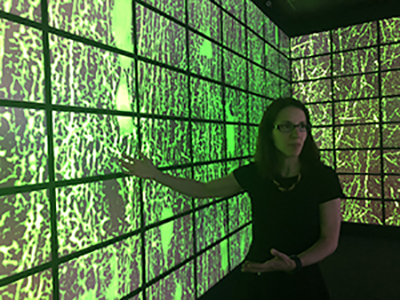
Innovative study of neuron loss may lead to more targeted treatments
As a direct result of the pilot data that a team of Stony Brook University researchers was able to obtain through funding from the Alzheimer's Foundation of America (AFA) in 2018, the team was recently awarded $4.3 million over five years from the National institutes of Health (NIH), in September, 2019, to execute the study. The research team will now develop an approach to find the source of the damage to cholinergic neurons that results in Alzheimer's disease.
Alzheimer’s disease is the sixth leading cause of death in the United States, and the only one in the top 10 without a cure or reversible treatment. Currently, more than 400,000 New Yorkers, including 50,000 Long Islanders, are living with Alzheimer’s.
“This study has the potential to lead to the development of effective medications that specifically target the damaged areas of the brain and return the neurons to a state of health in people with Alzheimer’s,” said Kenneth Kaushansky, MD, Dean of the Renaissance School of Medicine at Stony Brook University and Senior Vice President for the Health Sciences, Stony Brook Medicine.
A marriage of engineering and medicine
Led by biomedical engineer, Christine DeLorenzo, PhD, the interdisciplinary study involves both engineering and neuroscience, and strong interactions between basic neuroscience and translational researchers at the National Institutes of Health.
Pinpointing when and how cholinergic system damage occurs
The brain’s cholinergic system is unique in that it’s a network of long, very delicate neurons. It’s known that this fragile system is compromised first in Alzheimer’s disease and that it regulates memory function. As early as the 1970s, medications were developed to improve the cholinergic system to reverse the loss of memory observed in people with diseases such as Alzheimer’s.
But unfortunately, as most caretakers of people with Alzheimer’s can attest, these medications are ineffective. This is likely because, without an in-depth understanding of the damage that occurs in Alzheimer’s disease, these medications don’t have specific targets to repair. It is this understanding that the Stony Brook study will begin to provide by probing when and how this damage occurs.
“The result of this study will be the most comprehensive investigation of the cholinergic brain system to date, and our study stands to advance both the fields of neuroscience and neuroimaging,” said Dr. DeLorenzo, Principal Investigator of the study and Director of Stony Brook's Center for Understanding Biology Using Imaging Technology (CUBIT).
Parallel studies in mice and humans using PET/MRI
Stony Brook Medicine is one of the few institutions in the world that can image the cholinergic system in the living brains of both mice and people, using Positron Emission Tomography (PET). This will allow the researchers to transfer the knowledge from their careful studies done in mice with the same gene expression seen in Alzheimer’s to improve their understanding of the cholinergic system in people.
Using Stony Brook Medicine’s simultaneous PET/MRI, the team of researchers will further increase their knowledge of the cholinergic system and its far-reaching effects by examining the consequences of cholinergic system changes on brain structure and function. PET and MRI imaging will occur at the same time within the same scanner, allowing the researchers to obtain a comprehensive view of people’s brains in health and disease.
The research team
Principal Investigator Dr. DeLorenzo’s co-investigators for this study include Ramin Parsey, MD, PhD, (Chair, Department of Psychiatry, Renaissance School of Medicine at Stony Brook University); Lorna Role, PhD, (Scientific Director, National Institute of Neurological Disorders and Stroke); David Talmage, PhD, (Senior Scientist, National Institute of Mental Health); Nikhil Palekar, MD, (Medical Director, Stony Brook Center of Excellence for Alzheimer’s Disease); and Mala Ananth, PhD, (Postdoctoral Fellow, Neurosciences, Renaissance School of Medicine at Stony Brook University).
Stony Brook’s Alzheimer’s commitment spans over 30 years
While this study will help push forward the frontiers of biomedical research on Alzheimer’s in the emerging field of neurotherapeutics, Stony Brook Medicine has been a leader in the region for combating Alzheimer’s disease for over three decades at Stony Brook University Neurosciences Institute— through basic, translational and clinical research, diagnosis, treatment, as well as education. This commitment is also demonstrated by the activities and programs of the Stony Brook Center of Excellence for Alzheimer’s Disease, one of only 10 centers supported in part by a grant from the New York State Department of Health, serving Suffolk and Nassau counties.
